Israeli vs Nepalese Community Comparison
COMPARE
Israeli
Nepalese
Social Comparison
Social Comparison
Israelis
Nepalese
6,737
SOCIAL INDEX
64.9/ 100
SOCIAL RATING
145th/ 347
SOCIAL RANK
1,939
SOCIAL INDEX
16.9/ 100
SOCIAL RATING
281st/ 347
SOCIAL RANK
Nepalese Integration in Israeli Communities
The statistical analysis conducted on geographies consisting of 16,802,796 people shows a weak negative correlation between the proportion of Nepalese within Israeli communities in the United States with a correlation coefficient (R) of -0.278. On average, for every 1% (one percent) increase in Israelis within a typical geography, there is a decrease of 0.015% in Nepalese. To illustrate, in a geography comprising of 100,000 individuals, a rise of 1,000 Israelis corresponds to a decrease of 14.7 Nepalese.
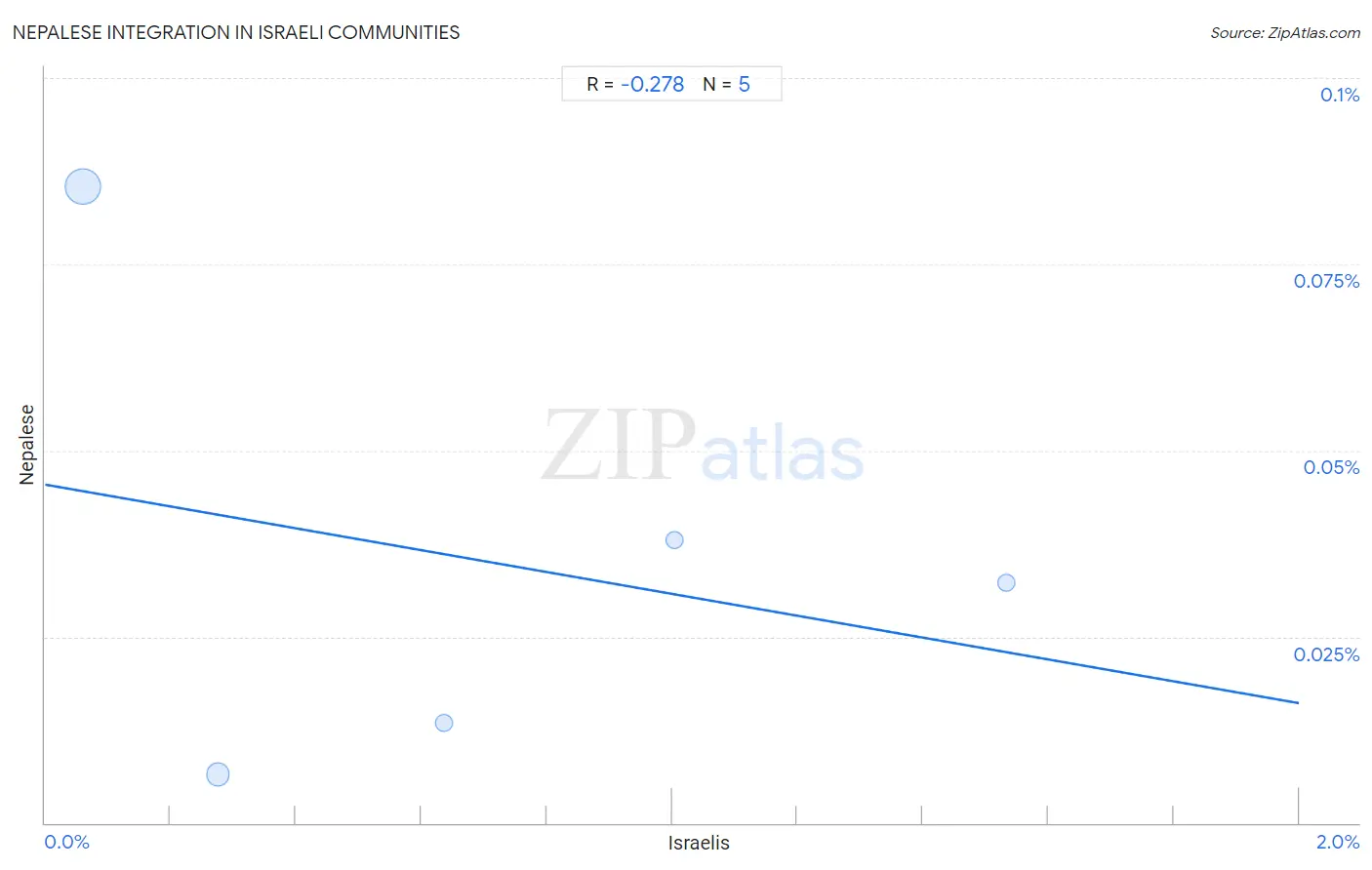
Israeli vs Nepalese Income
When considering income, the most significant differences between Israeli and Nepalese communities in the United States are seen in per capita income ($52,596 compared to $38,442, a difference of 36.8%), median male earnings ($63,228 compared to $49,458, a difference of 27.8%), and median family income ($118,577 compared to $94,153, a difference of 25.9%). Conversely, both communities are more comparable in terms of householder income under 25 years ($52,335 compared to $54,472, a difference of 4.1%), householder income over 65 years ($66,636 compared to $58,761, a difference of 13.4%), and median female earnings ($43,852 compared to $38,603, a difference of 13.6%).

| Income Metric | Israeli | Nepalese |
| Per Capita Income | Exceptional $52,596 | Tragic $38,442 |
| Median Family Income | Exceptional $118,577 | Tragic $94,153 |
| Median Household Income | Exceptional $96,552 | Poor $82,410 |
| Median Earnings | Exceptional $52,937 | Tragic $43,860 |
| Median Male Earnings | Exceptional $63,228 | Tragic $49,458 |
| Median Female Earnings | Exceptional $43,852 | Tragic $38,603 |
| Householder Age | Under 25 years | Average $52,335 | Exceptional $54,472 |
| Householder Age | 25 - 44 years | Exceptional $107,579 | Poor $91,498 |
| Householder Age | 45 - 64 years | Exceptional $114,186 | Tragic $93,355 |
| Householder Age | Over 65 years | Exceptional $66,636 | Tragic $58,761 |
| Wage/Income Gap | Tragic 27.4% | Exceptional 22.2% |
Israeli vs Nepalese Poverty
When considering poverty, the most significant differences between Israeli and Nepalese communities in the United States are seen in receiving food stamps (10.7% compared to 14.6%, a difference of 36.3%), married-couple family poverty (5.3% compared to 6.5%, a difference of 22.7%), and child poverty among girls under 16 (15.6% compared to 18.6%, a difference of 19.3%). Conversely, both communities are more comparable in terms of seniors poverty over the age of 65 (11.3% compared to 11.5%, a difference of 1.5%), female poverty among 18-24 year olds (20.9% compared to 20.2%, a difference of 3.3%), and seniors poverty over the age of 75 (13.2% compared to 12.6%, a difference of 4.2%).
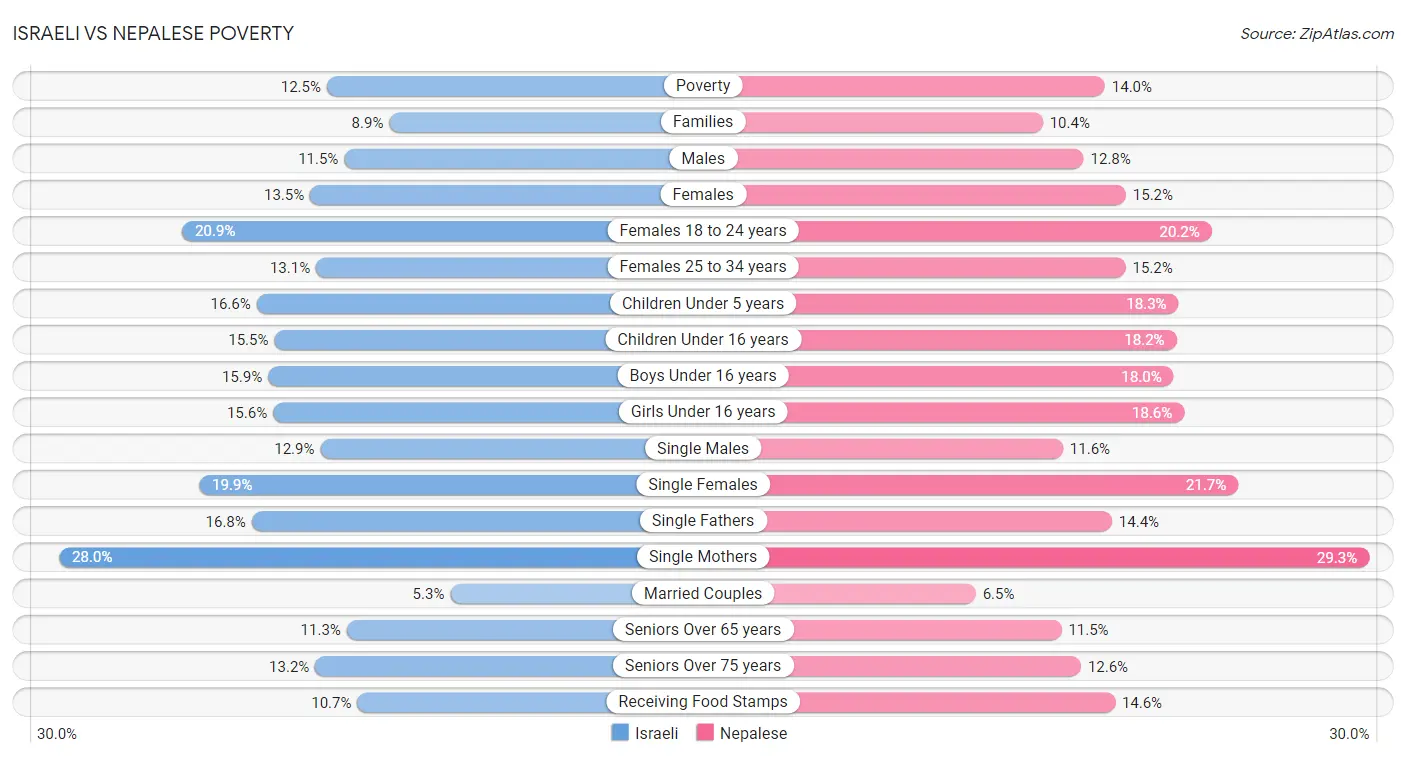
| Poverty Metric | Israeli | Nepalese |
| Poverty | Fair 12.5% | Tragic 14.0% |
| Families | Good 8.9% | Tragic 10.4% |
| Males | Fair 11.5% | Tragic 12.8% |
| Females | Average 13.5% | Tragic 15.2% |
| Females 18 to 24 years | Tragic 20.9% | Fair 20.2% |
| Females 25 to 34 years | Excellent 13.1% | Tragic 15.2% |
| Children Under 5 years | Excellent 16.6% | Tragic 18.3% |
| Children Under 16 years | Excellent 15.5% | Tragic 18.2% |
| Boys Under 16 years | Good 15.9% | Tragic 18.0% |
| Girls Under 16 years | Excellent 15.6% | Tragic 18.6% |
| Single Males | Average 12.9% | Exceptional 11.6% |
| Single Females | Exceptional 19.9% | Tragic 21.7% |
| Single Fathers | Tragic 16.8% | Exceptional 14.4% |
| Single Mothers | Exceptional 28.0% | Fair 29.3% |
| Married Couples | Fair 5.3% | Tragic 6.5% |
| Seniors Over 65 years | Poor 11.3% | Tragic 11.5% |
| Seniors Over 75 years | Tragic 13.2% | Poor 12.6% |
| Receiving Food Stamps | Exceptional 10.7% | Tragic 14.6% |
Israeli vs Nepalese Unemployment
When considering unemployment, the most significant differences between Israeli and Nepalese communities in the United States are seen in unemployment among seniors over 75 years (7.4% compared to 10.1%, a difference of 36.2%), unemployment among ages 35 to 44 years (4.7% compared to 5.6%, a difference of 18.4%), and male unemployment (5.5% compared to 6.4%, a difference of 17.2%). Conversely, both communities are more comparable in terms of unemployment among ages 20 to 24 years (10.6% compared to 10.6%, a difference of 0.31%), unemployment among ages 60 to 64 years (5.2% compared to 5.2%, a difference of 1.4%), and unemployment among seniors over 65 years (5.3% compared to 5.1%, a difference of 2.7%).
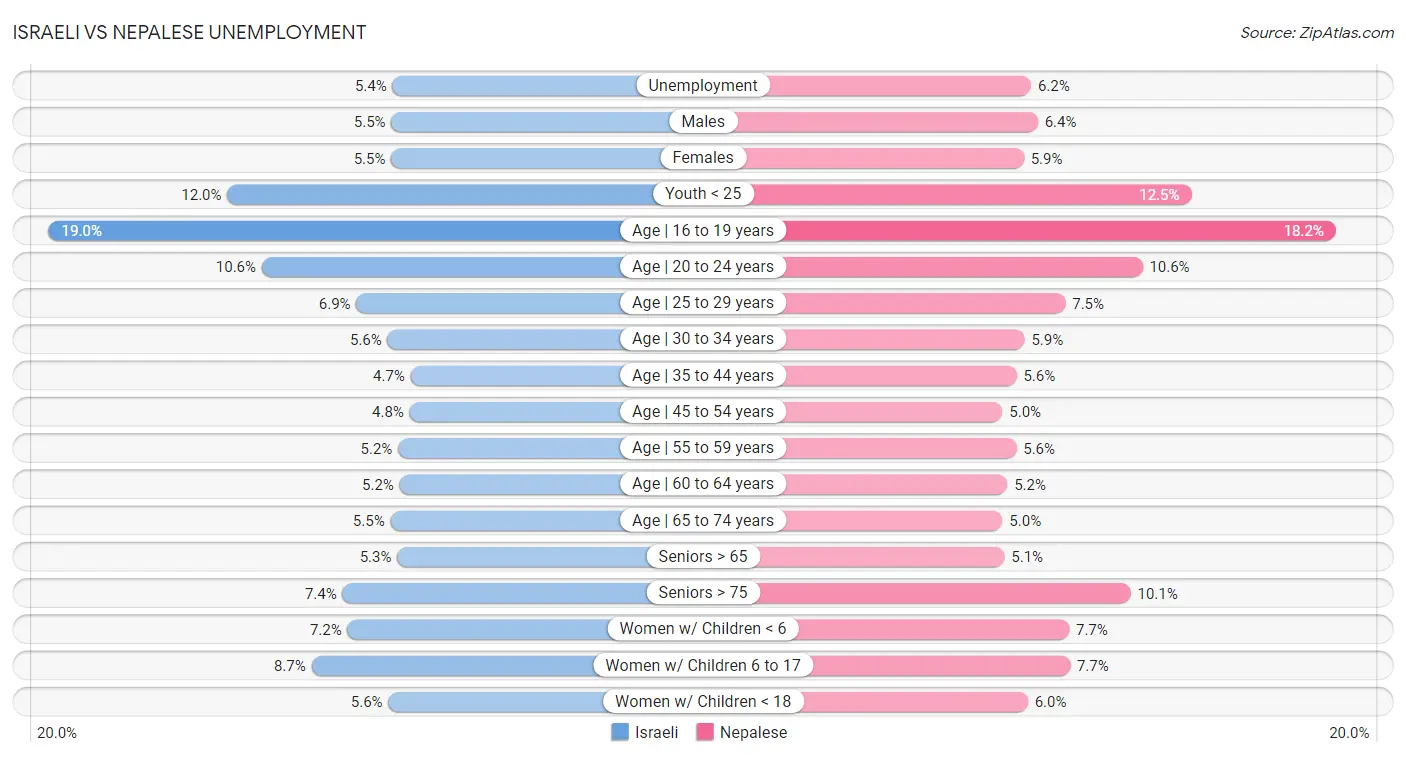
| Unemployment Metric | Israeli | Nepalese |
| Unemployment | Tragic 5.4% | Tragic 6.2% |
| Males | Tragic 5.5% | Tragic 6.4% |
| Females | Tragic 5.5% | Tragic 5.9% |
| Youth < 25 | Tragic 12.0% | Tragic 12.5% |
| Age | 16 to 19 years | Tragic 19.0% | Tragic 18.2% |
| Age | 20 to 24 years | Tragic 10.6% | Tragic 10.6% |
| Age | 25 to 29 years | Tragic 6.9% | Tragic 7.5% |
| Age | 30 to 34 years | Poor 5.6% | Tragic 5.9% |
| Age | 35 to 44 years | Fair 4.7% | Tragic 5.6% |
| Age | 45 to 54 years | Tragic 4.8% | Tragic 5.0% |
| Age | 55 to 59 years | Tragic 5.2% | Tragic 5.6% |
| Age | 60 to 64 years | Tragic 5.2% | Tragic 5.2% |
| Age | 65 to 74 years | Tragic 5.5% | Exceptional 5.0% |
| Seniors > 65 | Tragic 5.3% | Good 5.1% |
| Seniors > 75 | Exceptional 7.4% | Tragic 10.1% |
| Women w/ Children < 6 | Exceptional 7.2% | Average 7.7% |
| Women w/ Children 6 to 17 | Exceptional 8.7% | Exceptional 7.7% |
| Women w/ Children < 18 | Poor 5.6% | Tragic 6.0% |
Israeli vs Nepalese Labor Participation
When considering labor participation, the most significant differences between Israeli and Nepalese communities in the United States are seen in in labor force | age 16-19 (32.4% compared to 33.5%, a difference of 3.4%), in labor force | age 45-54 (82.7% compared to 80.5%, a difference of 2.6%), and in labor force | age 20-24 (72.6% compared to 74.5%, a difference of 2.6%). Conversely, both communities are more comparable in terms of in labor force | age 25-29 (84.3% compared to 82.9%, a difference of 1.7%), in labor force | age 35-44 (84.1% compared to 82.4%, a difference of 2.1%), and in labor force | age > 16 (65.2% compared to 63.8%, a difference of 2.2%).

| Labor Participation Metric | Israeli | Nepalese |
| In Labor Force | Age > 16 | Good 65.2% | Tragic 63.8% |
| In Labor Force | Age 20-64 | Fair 79.5% | Tragic 77.5% |
| In Labor Force | Age 16-19 | Tragic 32.4% | Tragic 33.5% |
| In Labor Force | Age 20-24 | Tragic 72.6% | Poor 74.5% |
| In Labor Force | Age 25-29 | Tragic 84.3% | Tragic 82.9% |
| In Labor Force | Age 30-34 | Average 84.7% | Tragic 82.7% |
| In Labor Force | Age 35-44 | Poor 84.1% | Tragic 82.4% |
| In Labor Force | Age 45-54 | Fair 82.7% | Tragic 80.5% |
Israeli vs Nepalese Family Structure
When considering family structure, the most significant differences between Israeli and Nepalese communities in the United States are seen in single father households (2.0% compared to 3.1%, a difference of 58.2%), single mother households (5.7% compared to 7.5%, a difference of 31.2%), and births to unmarried women (28.6% compared to 33.5%, a difference of 17.3%). Conversely, both communities are more comparable in terms of married-couple households (46.7% compared to 45.6%, a difference of 2.4%), currently married (46.6% compared to 44.7%, a difference of 4.2%), and average family size (3.23 compared to 3.42, a difference of 6.0%).

| Family Structure Metric | Israeli | Nepalese |
| Family Households | Tragic 63.1% | Exceptional 67.2% |
| Family Households with Children | Average 27.5% | Exceptional 30.5% |
| Married-couple Households | Good 46.7% | Poor 45.6% |
| Average Family Size | Average 3.23 | Exceptional 3.42 |
| Single Father Households | Exceptional 2.0% | Tragic 3.1% |
| Single Mother Households | Exceptional 5.7% | Tragic 7.5% |
| Currently Married | Average 46.6% | Tragic 44.7% |
| Divorced or Separated | Exceptional 11.3% | Tragic 12.5% |
| Births to Unmarried Women | Exceptional 28.6% | Tragic 33.5% |
Israeli vs Nepalese Vehicle Availability
When considering vehicle availability, the most significant differences between Israeli and Nepalese communities in the United States are seen in no vehicles in household (12.4% compared to 7.4%, a difference of 68.3%), 4 or more vehicles in household (5.2% compared to 8.7%, a difference of 67.2%), and 3 or more vehicles in household (16.8% compared to 24.9%, a difference of 48.6%). Conversely, both communities are more comparable in terms of 1 or more vehicles in household (87.7% compared to 92.6%, a difference of 5.7%), 2 or more vehicles in household (51.9% compared to 61.4%, a difference of 18.4%), and 3 or more vehicles in household (16.8% compared to 24.9%, a difference of 48.6%).

| Vehicle Availability Metric | Israeli | Nepalese |
| No Vehicles Available | Tragic 12.4% | Exceptional 7.4% |
| 1+ Vehicles Available | Tragic 87.7% | Exceptional 92.6% |
| 2+ Vehicles Available | Tragic 51.9% | Exceptional 61.4% |
| 3+ Vehicles Available | Tragic 16.8% | Exceptional 24.9% |
| 4+ Vehicles Available | Tragic 5.2% | Exceptional 8.7% |
Israeli vs Nepalese Education Level
When considering education level, the most significant differences between Israeli and Nepalese communities in the United States are seen in doctorate degree (2.7% compared to 1.3%, a difference of 117.0%), professional degree (6.9% compared to 3.2%, a difference of 114.2%), and no schooling completed (1.9% compared to 3.8%, a difference of 98.8%). Conversely, both communities are more comparable in terms of nursery school (98.1% compared to 96.2%, a difference of 2.0%), kindergarten (98.1% compared to 96.2%, a difference of 2.0%), and 1st grade (98.1% compared to 96.1%, a difference of 2.0%).
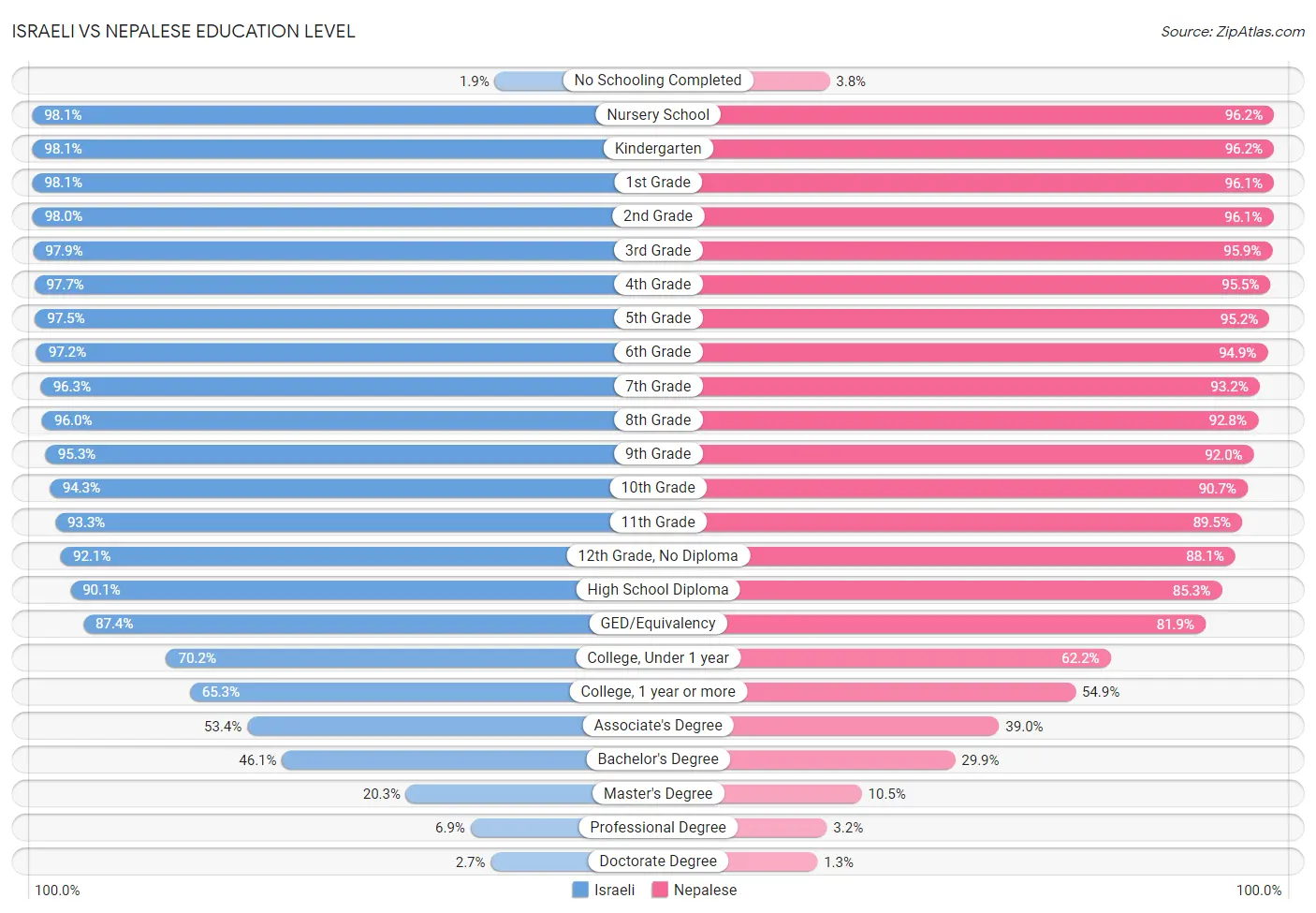
| Education Level Metric | Israeli | Nepalese |
| No Schooling Completed | Exceptional 1.9% | Tragic 3.8% |
| Nursery School | Excellent 98.1% | Tragic 96.2% |
| Kindergarten | Excellent 98.1% | Tragic 96.2% |
| 1st Grade | Excellent 98.1% | Tragic 96.1% |
| 2nd Grade | Excellent 98.0% | Tragic 96.1% |
| 3rd Grade | Excellent 97.9% | Tragic 95.9% |
| 4th Grade | Excellent 97.7% | Tragic 95.5% |
| 5th Grade | Excellent 97.5% | Tragic 95.2% |
| 6th Grade | Excellent 97.2% | Tragic 94.9% |
| 7th Grade | Excellent 96.3% | Tragic 93.2% |
| 8th Grade | Excellent 96.0% | Tragic 92.8% |
| 9th Grade | Exceptional 95.3% | Tragic 92.0% |
| 10th Grade | Exceptional 94.3% | Tragic 90.7% |
| 11th Grade | Exceptional 93.3% | Tragic 89.5% |
| 12th Grade, No Diploma | Exceptional 92.1% | Tragic 88.1% |
| High School Diploma | Exceptional 90.1% | Tragic 85.3% |
| GED/Equivalency | Exceptional 87.4% | Tragic 81.9% |
| College, Under 1 year | Exceptional 70.2% | Tragic 62.2% |
| College, 1 year or more | Exceptional 65.3% | Tragic 54.9% |
| Associate's Degree | Exceptional 53.4% | Tragic 39.0% |
| Bachelor's Degree | Exceptional 46.1% | Tragic 29.9% |
| Master's Degree | Exceptional 20.3% | Tragic 10.5% |
| Professional Degree | Exceptional 6.9% | Tragic 3.2% |
| Doctorate Degree | Exceptional 2.7% | Tragic 1.3% |
Israeli vs Nepalese Disability
When considering disability, the most significant differences between Israeli and Nepalese communities in the United States are seen in disability age 65 to 74 (21.2% compared to 28.0%, a difference of 32.5%), disability age 35 to 64 (9.7% compared to 12.8%, a difference of 31.8%), and vision disability (2.0% compared to 2.4%, a difference of 23.4%). Conversely, both communities are more comparable in terms of cognitive disability (17.0% compared to 18.0%, a difference of 5.8%), disability age 5 to 17 (5.0% compared to 5.3%, a difference of 6.1%), and disability age over 75 (46.4% compared to 52.6%, a difference of 13.3%).
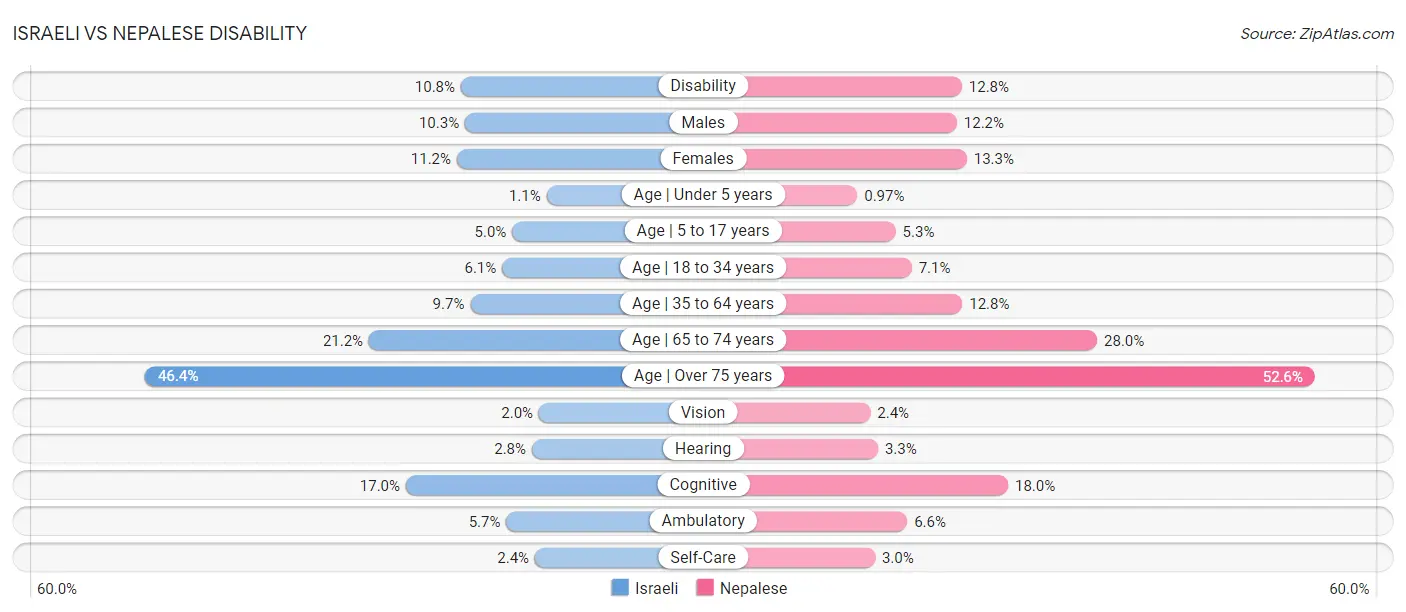
| Disability Metric | Israeli | Nepalese |
| Disability | Exceptional 10.8% | Tragic 12.8% |
| Males | Exceptional 10.3% | Tragic 12.2% |
| Females | Exceptional 11.2% | Tragic 13.3% |
| Age | Under 5 years | Exceptional 1.1% | Exceptional 0.97% |
| Age | 5 to 17 years | Exceptional 5.0% | Exceptional 5.3% |
| Age | 18 to 34 years | Exceptional 6.1% | Tragic 7.1% |
| Age | 35 to 64 years | Exceptional 9.7% | Tragic 12.8% |
| Age | 65 to 74 years | Exceptional 21.2% | Tragic 28.0% |
| Age | Over 75 years | Exceptional 46.4% | Tragic 52.6% |
| Vision | Exceptional 2.0% | Tragic 2.4% |
| Hearing | Exceptional 2.8% | Tragic 3.3% |
| Cognitive | Exceptional 17.0% | Tragic 18.0% |
| Ambulatory | Exceptional 5.7% | Tragic 6.6% |
| Self-Care | Good 2.4% | Tragic 3.0% |